(完整word版)英语教案全英模板
- 格式:doc
- 大小:32.00 KB
- 文档页数:3
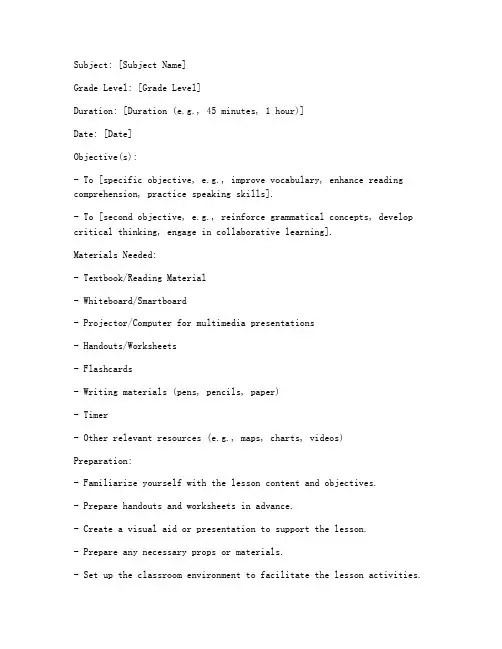
Subject: [Subject Name]Grade Level: [Grade Level]Duration: [Duration (e.g., 45 minutes, 1 hour)]Date: [Date]Objective(s):- To [specific objective, e.g., improve vocabulary, enhance reading comprehension, practice speaking skills].- To [second objective, e.g., reinforce grammatical concepts, develop critical thinking, engage in collaborative learning].Materials Needed:- Textbook/Reading Material- Whiteboard/Smartboard- Projector/Computer for multimedia presentations- Handouts/Worksheets- Flashcards- Writing materials (pens, pencils, paper)- Timer- Other relevant resources (e.g., maps, charts, videos)Preparation:- Familiarize yourself with the lesson content and objectives.- Prepare handouts and worksheets in advance.- Create a visual aid or presentation to support the lesson.- Prepare any necessary props or materials.- Set up the classroom environment to facilitate the lesson activities.Introduction (5 minutes):- Greet students and check for attendance.- Review the objectives of the lesson.- Engage students with a warm-up activity or question to activate prior knowledge.Teaching Activity (25 minutes):1. Vocabulary Development:- Introduce new vocabulary words related to the lesson topic.- Use flashcards or a presentation to display the words.- Have students form sentences using the new vocabulary.2. Reading Comprehension:- Present a reading passage or article related to the lesson topic.- Guide students through a reading activity, such as skimming, scanning, or close reading.- Ask comprehension questions to ensure understanding.3. Grammar Practice:- Review and practice specific grammatical structures or concepts.- Use examples and exercises to reinforce the grammar points.- Provide immediate feedback and corrections.4. Speaking and Listening:- Conduct group discussions or role-playing activities.- Encourage students to speak in complete sentences and use the target language.- Provide opportunities for students to ask questions and respond to their peers.5. Collaborative Learning:- Assign small group tasks or projects.- Monitor student progress and provide guidance as needed.- Facilitate peer-to-peer learning and feedback.Assessment:- Observe student participation and engagement.- Assess understanding through questioning and responses.- Evaluate student performance on worksheets, quizzes, or oral presentations.Conclusion (5 minutes):- Summarize the main points of the lesson.- Reinforce key vocabulary and grammar concepts.- Provide feedback and encourage students to reflect on their learning.Homework Assignment:- Assign relevant homework that reinforces the lesson objectives.- Provide clear instructions and due dates.Reflection:- Reflect on the effectiveness of the lesson.- Identify areas for improvement and consider modifications for future lessons.---Example Lesson Plan:Subject: English as a Second Language (ESL)Grade Level: BeginnerDuration: 1 hourDate: March 10, 2023Objective(s):- To introduce basic greetings and self-introduction phrases in English.- To practice listening and speaking skills through interactive activities.Materials Needed:- ESL textbook- Whiteboard- Projector- Handouts with pictures of common greetings- Writing materialsPreparation:- Prepare a PowerPoint presentation with images of people greeting each other.- Create a handout with sentences for students to practice.Introduction (5 minutes):- Greet students and check for attendance.- Introduce the lesson objective: to learn and practice basic greetings.- Engage students with a question: "How do you greet someone in your native language?"Teaching Activity (。
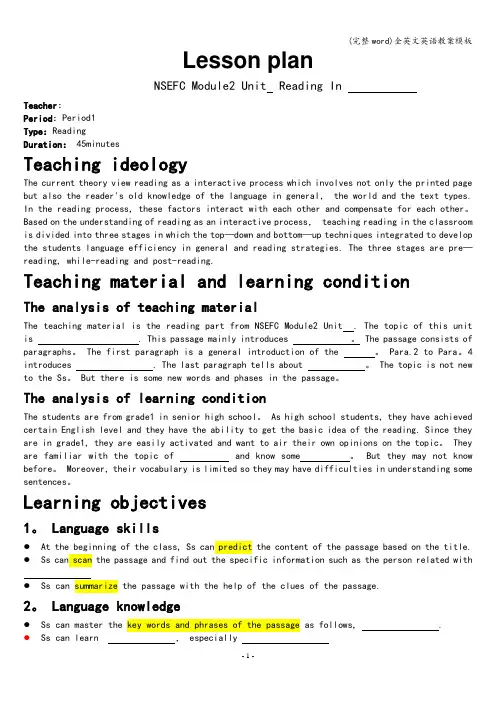
Lesson planNSEFC Module2 Unit Reading InTeacher:Period:Period1Type:ReadingDuration: 45minutesTeaching ideologyThe current theory view reading as a interactive process which involves not only the printed pagebut also the reader's old knowledge of the language in general, the world and the text types.In the reading process, these factors interact with each other and compensate for each other。
Based on the understanding of reading as an interactive process, teaching reading in the classroomis divided into three stages in which the top—down and bottom—up techniques integrated to developthe students language efficiency in general and reading strategies. The three stages are pre—reading, while-reading and post-reading.Teaching material and learning conditionThe analysis of teaching materialThe teaching material is the reading part from NSEFC Module2 Unit . The topic of this unitis . This passage mainly introduces 。
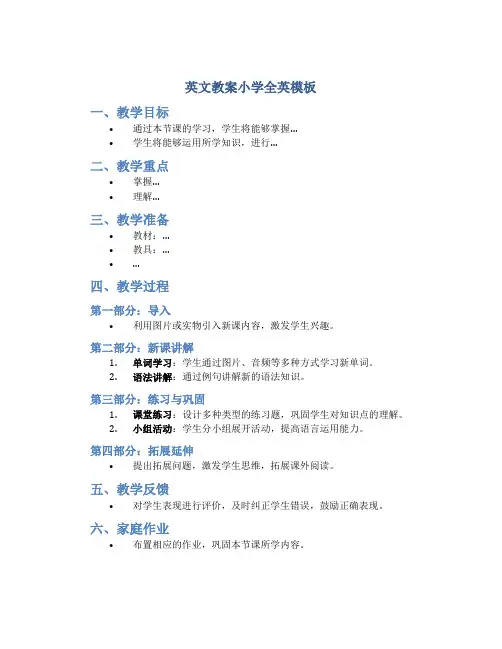
英文教案小学全英模板
一、教学目标
•通过本节课的学习,学生将能够掌握…
•学生将能够运用所学知识,进行…
二、教学重点
•掌握…
•理解…
三、教学准备
•教材:…
•教具:…
•…
四、教学过程
第一部分:导入
•利用图片或实物引入新课内容,激发学生兴趣。
第二部分:新课讲解
1.单词学习:学生通过图片、音频等多种方式学习新单词。
2.语法讲解:通过例句讲解新的语法知识。
第三部分:练习与巩固
1.课堂练习:设计多种类型的练习题,巩固学生对知识点的理解。
2.小组活动:学生分小组展开活动,提高语言运用能力。
第四部分:拓展延伸
•提出拓展问题,激发学生思维,拓展课外阅读。
五、教学反馈
•对学生表现进行评价,及时纠正学生错误,鼓励正确表现。
六、家庭作业
•布置相应的作业,巩固本节课所学内容。
七、教后反思
•总结本节课教学过程,查找不足并设想改进方法。
这个教案模板旨在帮助老师规划和设计一堂全英文的小学英语课程,灵活运用各种教学方法,提高学生的学习兴趣和语言运用能力。
希望能为您的英语教学提供一定的参考价值。
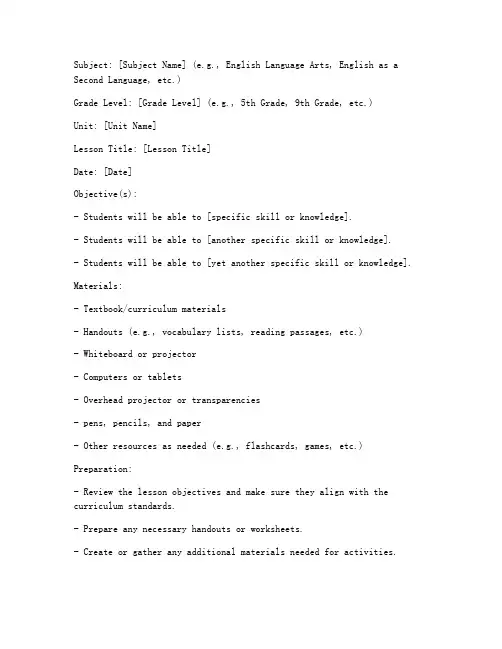
Subject: [Subject Name] (e.g., English Language Arts, English as a Second Language, etc.)Grade Level: [Grade Level] (e.g., 5th Grade, 9th Grade, etc.)Unit: [Unit Name]Lesson Title: [Lesson Title]Date: [Date]Objective(s):- Students will be able to [specific skill or knowledge].- Students will be able to [another specific skill or knowledge].- Students will be able to [yet another specific skill or knowledge].Materials:- Textbook/curriculum materials- Handouts (e.g., vocabulary lists, reading passages, etc.)- Whiteboard or projector- Computers or tablets- Overhead projector or transparencies- pens, pencils, and paper- Other resources as needed (e.g., flashcards, games, etc.)Preparation:- Review the lesson objectives and make sure they align with the curriculum standards.- Prepare any necessary handouts or worksheets.- Create or gather any additional materials needed for activities.- Familiarize yourself with the content and plan the sequence of activities.- Prepare a warm-up activity that is engaging and relevant to the lesson.Warm-Up (5-10 minutes):- Begin the lesson with a brief review or an interactive activity that relates to the new content.- Example: If the lesson is about verb tenses, start with a quick quiz on past, present, and future tenses.Introduction (10-15 minutes):- Introduce the topic and objectives of the lesson.- Provide any necessary background information.- Example: "Today, we are going to learn about the past perfect tense. We will understand when and how to use it in sentences."Instruction (20-30 minutes):- Explain the key concepts or vocabulary using clear, concise language.- Use examples and explanations to illustrate the new material.- Example: "The past perfect tense is used to describe an action that happened before another past action. It is formed with 'had' + past participle."Activities (20-30 minutes):- Engage students in various activities to practice the new skills.- Include a mix of individual, pair, and group work.- Example:1. Pair work: Students complete a fill-in-the-blank exercise using the past perfect tense.2. Group activity: Students create a short dialogue using the past perfect tense.3. Individual activity: Students write a short paragraph describing an event using the past perfect tense.Assessment (10-15 minutes):- Assess students' understanding of the new material through various means.- Example:1. Exit ticket: Students write a sentence using the past perfect tense.2. Quick quiz: Students answer a few questions about the past perfect tense.3. Observation: Teacher observes student participation and engagement in activities.Closure (5-10 minutes):- Summarize the key points of the lesson.- Review any vocabulary or concepts that were challenging.- Example: "To review, the past perfect tense is used to describe past actions before other past actions. Remember to use 'had' followed by the past participle."Homework Assignment:- Assign relevant homework to reinforce the lesson's content.- Example: Students are asked to write a short story using the past perfect tense.Reflection:- After the lesson, reflect on what worked well and what could be improved.- Consider student feedback and adjust the lesson plan accordingly for future use.Note:- This template is a guide and can be adapted to fit different teaching styles, student needs, and curriculum requirements.- Be sure to include any specific instructions or considerations related to your school's policies, resources, and student demographics.。
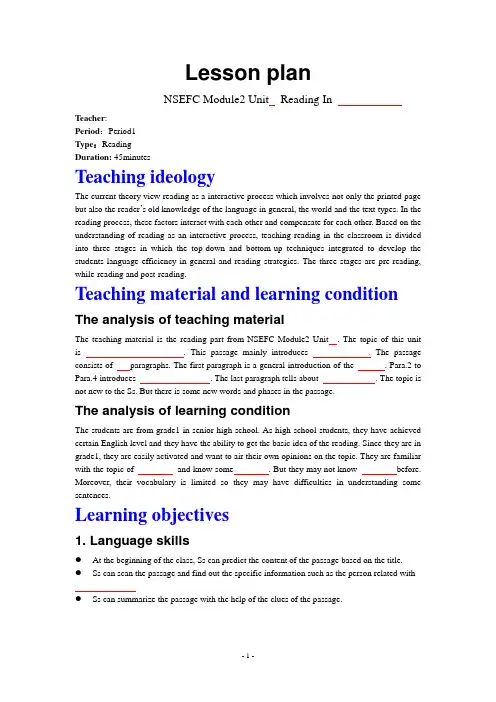
Lesson planNSEFC Module2 Unit Reading InTeacher:Period:Period1Type:ReadingDuration: 45minutesTeaching ideologyThe current theory view reading as a interactive process which involves not only the printed page but also the reader’s old knowledge of the language in general, the world and the text types. In the reading process, these factors interact with each other and compensate for each other. Based on the understanding of reading as an interactive process, teaching reading in the classroom is divided into three stages in which the top-down and bottom-up techniques integrated to develop the students language efficiency in general and reading strategies. The three stages are pre-reading, while-reading and post-reading.Teaching material and learning condition The analysis of teaching materialThe teaching material is the reading part from NSEFC Module2 Unit. The topic of this unit is . This passage mainly introduces .The passage consists of paragraphs. The first paragraph is a general introduction of the . Para.2 to Para.4 introduces . The last paragraph tells about . The topic is not new to the Ss. But there is some new words and phases in the passage.The analysis of learning conditionThe students are from grade1 in senior high school. As high school students, they have achieved certain English level and they have the ability to get the basic idea of the reading. Since they are in grade1, they are easily activated and want to air their own opinions on the topic. They are familiar with the topic of and know some. But they may not know before. Moreover, their vocabulary is limited so they may have difficulties in understanding some sentences.Learning objectives1. Language skills●At the beginning of the class, Ss can predict the content of the passage based on the title.●Ss can scan the passage and find out the specific information such as the person related with ●Ss can summarize the passage with the help of the clues of the passage.2. Language knowledge●Ss can master the key words and phrases of the passage as follows, .●Ss can learn , especially3. Affects●Ss will realize that and they will concern themselves with the issue of4. Cultural awareness●Ss will broaden their minds by knowing something about5. Learning strategies●Ss will cultivate their ability individual learning and cooperative learning by doing someactivities independently and some in groups.●Ss will communicate with each other in English while doing the group work. Language focuses and anticipated difficultiesLanguage focusesThis is a reading period so the focus is to cultivate the students’ reading skills. The many activities are designed to help Ss to train their reading skills, such as predicting, skimming, scanning and summarizing.It is also important for the Ss to master the new words and phrases.Anticipated difficultiesAs the Ss have a limited vocabulary, so they may have some difficulties in understanding the passage. So the teacher will help them learn the new words and phrases.Ss may did not heard before, so the teacher will tell them some background knowledge about it.Teaching methodThree-stage model: Based on the understanding of reading as an interactive process, teaching reading in the classroom is divided into three stages in which the top-down and bottom-up techniques integrated to develop the students language efficiency in general and reading strategies. The three stages are pre-reading, while-reading and post-reading.Teaching aidsMultimedia devices and PPT documents: In order to help Ss to fully understand the whole passage, I adopt Multimedia devices and PPT documents to bring the real-life situation into the classroom.Teaching proceduresStep1. Lead-in (6min)Activity1. Greetings and Free-talking (2min)T Leads into the topic by asking Ss some they know. Ss tell the name of the they know freely.T: Hello boys and girls.(Ss say hello to the teacher.)T: When we say , what appears in your minds?(Ss tell the things appear in their minds freely.)T: What are the ?(Ss tell some names of .)Activity2. Picture-talking (4min)T shows some pictures about the in China and abroad. After seeing the pictures, Ss are expected to tell the similarities of them.T: Just now, you talk about some in China. Now, let’s see some pictures of some . (T shows the pictures and Ss see them carefully.)T: What do the have in common?For example, they are very precious. What are your opinions?(T gives them some hints and Ss tell the characteristics of )[Aims]In this step, T first leads in the topic by talking with the Ss freely about the which is familiar to them and then Ss see some pictures and tell the characteristics. These two activities aim to arouse the Ss’interests in the topic and activate their old knowledge of . Then Ss will be mentally prepared for the reading comprehension. What’s more, when they are talking about the charateristics of, they will realize that the are rare and precious and they will concern themselves with the issue of .Step2. Pre-reading (3min)Activity1. Knowing something about (1min)T gives a brief introduction of the. Ss will know the.T: Today, we are going to learn . It is . Do you know what is? (T shows some pictures of and Ss get to know the .)Activity2. Predicting (2min)T asks Ss to read the title of the passage and then ask them some questions. Ss will predict the content of the passage with the help of the title.T: please look at the title “”, what does “动词” mean?(If the Ss can not give the answer, then T explain it.)T: In search means that people are looking for it. Why are people looking for it? Can you guess? What will the passage talk about?(Ss predict the content, but T will not give the answer here.)[Aims]In this step, the Ss first know some information of the ; the background information will make it easier for the Ss to understand the passage. Then T asks Ss to make predictions about the passage. It aims to help Ss develop the reading skills of predicting.Step3. While-reading (22min)Activity1. Skimming (4min)Ss skim the whole passage and find out and check their predictions.T: Why are people still ? Here is a multiple choice for you.Activity2. Scanning (3min)T presents several true or false statements and asks the Ss to scan the passage and judge the right from the wrong.(Keys: F,F,T,T,F)Activity3 Close-reading (15min)T designs various kinds of activities and Ss do the activities to fully understand the passage. Para.1T: Please read Para.1 carefully and then take some note about the .Para.2-4Please read Para.2-4 carefully and then find out the removal of the room.Please read Para.2-4 carefully and then find out the person related with the Amber Room and the things them down with it.Para.5Please read Para.5 carefully and then find out the the rebuilding of the amber room.[Aims]By doing some many activities, the Ss will develop their reading strategies and language efficiency. T help the Ss study the passage paragraph by paragraph.. Ss will learn some key words and phrases in the passage.Step4. Post-reading (12min)Activity1. Dissuasion (6min)Ss have learned the rebuilding of the passage and T asks the Ss to discuss whether people . T give the example of “” which is . Ss share their opinion on the issue and the reasons.Activity2. Role-play (6 min)T creates a situation in which a student of the class has visited the Amber Room, so he/she come back to introduce the amber room.Ss work in pairs, one act as the one who has visited the palace. The other acts as one who is curious about the Amber Room, they should make a dialogue.The beginning of the conversation is given.A: the one who has visited the palaceB: the one who is curious about the Amber Room[Aims]These two activities are to develop the Ss’comprehensive language competence. The role play serves to be an output of the reading and an evaluation of their learning.Homework (1min)Ss write a summery ofSs review the words and phrase of the passage and make sentence with each. Blackboard designInterpretationGood morning, ladies and gentlemen. It’s my great honor and pleasure to be here sharing my lesson with you.I have been ready to begin this representation with five parts. Analysis of the teaching material, the teaching aims, the important and difficult points, the studying methods, and the teaching procedure.Part 1 Teaching MaterialThe content of my lesson is New Senior English for China Book___ Unit____________________. This unit is about____________________ (topics). By studying of this unit, we’ll enable students to know_________________________ and develop the interest in___________________. At the same time, let the students learn how to____________________ (functional items). From this lesson, it starts___________________________(structures). (As we all know, reading belongs to the input during the process of the language learning. The input has great effect on output, such as speaking and writing.) Therefore, this lesson is in the important position of this unit. If the Ss can master it well, it will be helpful for them to learn the rest of this unit.Part 2 Teaching AimsAccording to the new standard curriculum and the syllabus (新课程标准和教学大纲), and after studying the teaching material, the teaching aims are the followings:1.Knowledge objects (语言目标:语音,词汇,语法,功能,话题)(1)The Ss can master the usage of the important words and expressions.(2)The Ss can use the __________________ (grammar) in the proper situation.(3)The Ss can understand the content of the lesson, talk about _______________________ (information) and get their own idea about_______________________________.2.Ability objects (技能目标:听,说,读,写)(1) To develop the Ss’abilities of listening, speaking, reading and writing(2) To guide Ss to set up effective studying strategies.(3) To improve the student’s reading ability, especially their skimming and scanningability.(4) To train the Ss’abilities of studying by themselves and cooperating .3.Emotion or moral objects (情感目标:兴趣,自信,合作,爱国,国际视野)(1)By completing the task, the Ss increase their interest in ____________________and set up self-confidence in _____________________.(2)Teach the Ss_________________________, put the moral education in the language study. Part 3 the Important and Difficult PointsBased on the requirement of the syllabus.The important points are__________________________ such as ______________. The difficult points are_________________________ for example_____________. Part 4 Teaching Methods As is known to us all, a good teaching method requires that the teacher should help Ss develop good sense of the English language. For achieving these teaching aims,1(after the analysis of the teaching material and teaching aims,) I will use the following methods according to the modern social communication teaching theories(现代社会交际教学理论) .1. Communicative Approach(交际教学法)2. Whole Language Teaching(整体语言教学法)3. Task-based Language Teaching (任务教学法)4. Total Situational Action (情景教学) a “scene —activity”teaching method , it establishes a real scene and the interaction between the teacher and the Ss. At the same time, CAI (电脑辅助教学) can provide a real situation with its sound and picture, it can develop the Ss creativity in learning English.Part 5 Teaching ProcedureStep 1. Lead-in. (_____min)___________________________________________________________________ Purpose of my design: (1) to catch Ss’attention about the class/topic/passage.(2) To set up suspense/develop interest in _______________.Step 2. Pre-readingTask 1. (Individual work, pair work, group work, class work; _____min)Let Ss _____________________________________________________________ Task 2. (Individual work, pair work, group work, class work; _____min)___________________________________________________________________ Now, let’s see what happened to the_______________/ let’s check whether it is right or not.Purpose of my design: (1) to get to know something about the _________________.(2) To have a better understanding about the importance of ___________________. Step 3. While-readingTask 1. (Individual work, pair work, group work, class work; _____min)Skimming: Ss should read the material fast to find out the main idea/topic sentence for each paragraph.Para 1 ___________________Para 2 ___________________Para 3 ___________________…Task 2. (Individual work, pair work, group work, class work; _____min)Scanning: Listen to the tape part by part to finish ___________________________.Task 3. (Individual work, pair work, group work, class work; _____min)Scanning: Guide Ss to read the material carefully and take some important notes, then answer the following questions.Task 4. (Individual work, pair work, group work, class work; _____min)Scanning: Ask Ss to read the material carefully and find out the correct answers to finish the following chart.第2/3页Purpose of my design: Enable students to understand the given material better by using different reading skills. And proper competition can arouse the Ss’interest in English learning. “Task-based”teaching method is used here to develop the Ss’ability of communication and also their ability of co-operation will be well trained. Step 4. Post-readingTask 1. (Individual work, pair work, group work, class work; _____min)(接task3)Ask Ss to close books and finish the summary according their notes. (接task4)Retell the story /Sum up the passage in Ss’own words according to the chart.Task 2. (Individual work, pair work, group work, class work; _____min)Discuss _______________________________________________with other group members and then choose a reporter to share their opinions about ____________________________________ with the whole class.Purpose of my design: I think If the Ss can finish this task well, they will benefit a lot in their spoken English. Most Ss can take their parts in the activities, especially for the Ss who have trouble in English study.Step 5. Homework1. __________________________________________________2. __________________________________________________Purpose of my design: Homework is so important and necessary for to master the knowledge they learned after class. It will check whether the Ss achieve the teaching aims.。
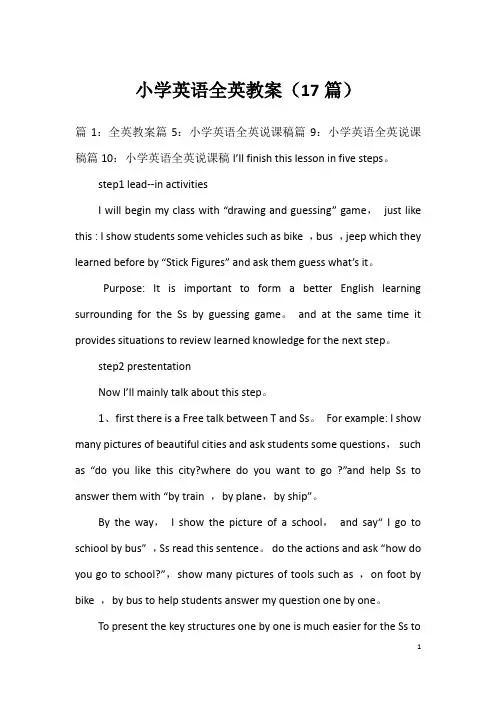
小学英语全英教案(17篇)篇1:全英教案篇5:小学英语全英说课稿篇9:小学英语全英说课稿篇10:小学英语全英说课稿I’ll finish this lesson in five steps。
step1 lead--in activitiesI will begin my class with “drawing and guessing” game,just like this : I show students some vehicles such as bike ,bus ,jeep which they learned before by “Stick Figures” and ask them guess what’s it。
Purpose: It is important to form a better English learning surrounding for the Ss by guessing game。
and at the same time it provides situations to review learned knowledge for the next step。
step2 prestentationNow I’ll mainly talk about this step。
1、first there is a Free talk between T and Ss。
For example: I show many pictures of beautiful cities and ask students some questions,such as “do you like this city?where do you want to go ?”and help Ss to answer them with “by train ,by plane,by ship”。
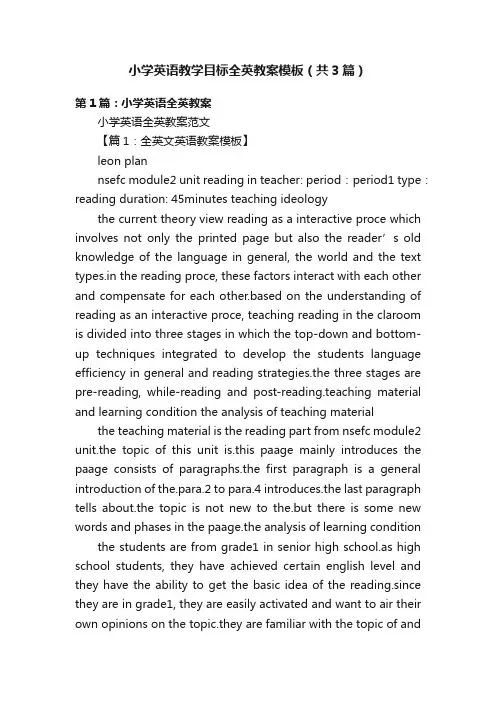
小学英语教学目标全英教案模板(共3篇)第1篇:小学英语全英教案小学英语全英教案范文【篇1:全英文英语教案模板】leon plannsefc module2 unit reading in teacher: period:period1 type:reading duration: 45minutes teaching ideologythe current theory view reading as a interactive proce which involves not only the printed page but also the reader’s old knowledge of the language in general, the world and the text types.in the reading proce, these factors interact with each other and compensate for each other.based on the understanding of reading as an interactive proce, teaching reading in the claroom is divided into three stages in which the top-down and bottom-up techniques integrated to develop the students language efficiency in general and reading strategies.the three stages are pre-reading, while-reading and post-reading.teaching material and learning condition the analysis of teaching material the teaching material is the reading part from nsefc module2 unit.the topic of this unit is.this paage mainly introduces the paage consists of paragraphs.the first paragraph is a general introduction of the.para.2 to para.4 introduces.the last paragraph tells about.the topic is not new to the.but there is some new words and phases in the paage.the analysis of learning condition the students are from grade1 in senior high school.as high school students, they have achieved certain english level and they have the ability to get the basic idea of the reading.since they are in grade1, they are easily activated and want to air their own opinions on the topic.they are familiar with the topic of andknow some.but they may not know before.moreover, their vocabulary is limited so they may have difficulties in understanding some sentences.learning objectives nguage skills ? at the beginning of the cla, can predict the content of the paage based on the title.? can scan the paage and find out the specific information such as the person related withcan summarize the paage with the help of the clues of the nguage knowledgecan master the key words and phrases of the paage as follows,.? can learn , especially 3.affectswill realize that and they will concern themselves with the iue of4.cultural awarenewill broaden their minds by knowing something about 5.learning strategieswill cultivate their ability individual learning and cooperative learning by doing someactivities independently and some in groups.? will communicate with each other in english while doing the group nguage difficultiesfocuses and anticipated language focusesthis is a reading period so the focus is to cultivate the students’ reading skills.the many activities are designed to help to train their reading skills, such as predicting, skimming, scanning and summarizing.it is also important for the to master the new words and phrases.anticipated difficultiesas the have a limited vocabulary, so they may have some difficulties in understanding the paage.so the teacher will help them learn the new words and phrases.may did not heard before, so the teacher will tell them some background knowledge aboutit.teaching methodthree-stage model: based on the understanding of reading as an interactive proce, teaching reading in the claroom is divided into three stages in which the top-down and bottom-up techniques integrated to develop the students language efficiency in general and reading strategies.the three stages are pre-reading, while-reading and post-reading.teaching aids multimedia devices and ppt documents: in order to help to fully understand the whole paage, i adopt multimedia devices and ppt documents to bring the real-life situation into the claroom.teaching procedures step1.lead-in(6min)activity1.greetings and free-talking(2min)t leads into the topic by asking some they know.tell the name of the they know freely.t: hello boys and girls.(say hello to the teacher.)t: when we say , what appears in your minds?(tell the things appear in their minds freely.)t: what are the ?(tell some names of.) activity2.picture-talking(4min)t shows some pictures about the in china and abroad.after seeing the pictures, are expected to tell the similarities of them.t: just now, you talk about some in china.now, let’s see some pictures of some.(t shows the pictures and see them carefully.) t: what do the have in common?for example, they are very precious.what are your opinions?(t gives them some hints and tell the characteristics of)[aims] in this step, t first leads in the topic by talking with the freely about the whichis familiar to them and then see some pictures and tell the characteristics.these two activities aim to arouse the ’ interests in the topic and activate their old knowledge of.then will bementally prepared for the reading comprehension.what’s more,when they are talking about the charateristics of, they will realize that theare rare and precious and they will concern themselves with the iue of.step2.pre-reading(3min)activity1.knowing something about(1min)t gives a brief introduction of the.will know the t: today, we are going to learn.it is.do you know what is?(t shows some pictures ofand get to know the.)activity2.predicting(2min)t asks to read the title of the paage and then ask them some questions.will predict the content of the paage with the help of the title.t: please look at the ti tle “”, what does “” mean?(if the can not give the answer, then t explain it.)t: in search means that people are looking for it.why are people looking for it? can you gue? what will the paage talk about?(predict the content, but t will not give the answer here.)[aims] in this step, the first know some information of the;the background information will make it easier for the to understand the paage.then t asks to make predictions about the paage.it aims to help develop the reading skills of predicting.step3.while-reading(22min)activity1.skimming(4min)skim the whole paage and find out and check their predictions.t: why are people still ? here is a multiple choice for you.activity2.scanning(3min)t presents several true or false statements and asks the to scan the paage and judge the right from the wrong.(keys: F,F,T,T,F)activity3 close-reading(15min)t designs various kinds of activities and do the activities to fully understand the paage.para.1t: please read para.1 carefully and then take some note aboutthe.para.2-4please read para.2-4 carefully and then find out the removal of the room.please read para.2-4 carefully and then find out the person related with the amber room and the things them down with it.para.5 please read para.5 carefully and then find out the the rebuilding of the amber room.【篇2:pep小学英语全英教案模板】the english teaching plan of pep book 4enhe primary school teacher:___________ the curriculum schedule cla:____________ cla:____________ the teaching schedule the students’ result tablethe english curriculum standard英语课程标准一级目标总体目标:对英语有好奇心,喜欢听他人说英语;能根据教师的简单指令做游戏、做动作、做事情(如涂颜色、连线);能做简单的角色扮演;能唱简单的英文歌曲,说简单的英语歌谣;能在图片的帮助下听懂和读懂简单的小故事;能交流简单的个人信息,表达简单的情感和感觉;能书写字母和单词;对英语学习中接触的外国文化习俗感兴趣。
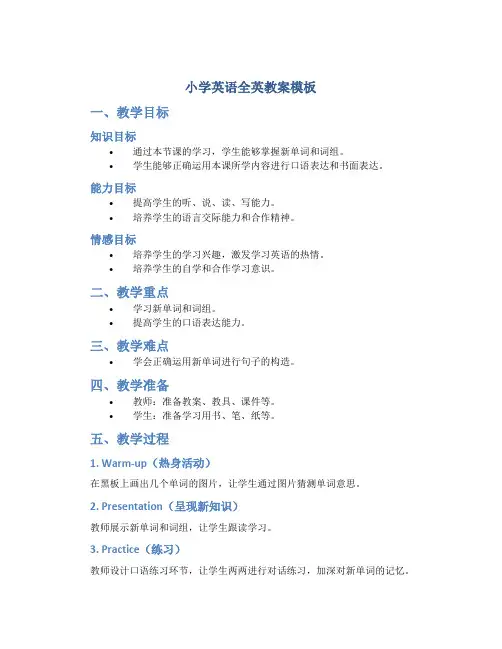
小学英语全英教案模板
一、教学目标
知识目标
•通过本节课的学习,学生能够掌握新单词和词组。
•学生能够正确运用本课所学内容进行口语表达和书面表达。
能力目标
•提高学生的听、说、读、写能力。
•培养学生的语言交际能力和合作精神。
情感目标
•培养学生的学习兴趣,激发学习英语的热情。
•培养学生的自学和合作学习意识。
二、教学重点
•学习新单词和词组。
•提高学生的口语表达能力。
三、教学难点
•学会正确运用新单词进行句子的构造。
四、教学准备
•教师:准备教案、教具、课件等。
•学生:准备学习用书、笔、纸等。
五、教学过程
1. Warm-up(热身活动)
在黑板上画出几个单词的图片,让学生通过图片猜测单词意思。
2. Presentation(呈现新知识)
教师展示新单词和词组,让学生跟读学习。
3. Practice(练习)
教师设计口语练习环节,让学生两两进行对话练习,加深对新单词的记忆。
4. Production(表达)
要求学生运用新学的单词和词组进行句子编写,展示个人观点。
5. Homework(作业布置)
布置相关作业,巩固所学内容。
六、教学反思
经过本节课的教学,学生对新单词的掌握情况如何?口语表达能力有所提高吗?如何改进教学方式提高学生的学习兴趣?
这份全英文教案模板力求通过多种学习方式和环节的设计,引导学生在轻松愉
悦的氛围中学习英语,培养其语言交际能力和合作精神,为日后的学习打下坚实的基础。
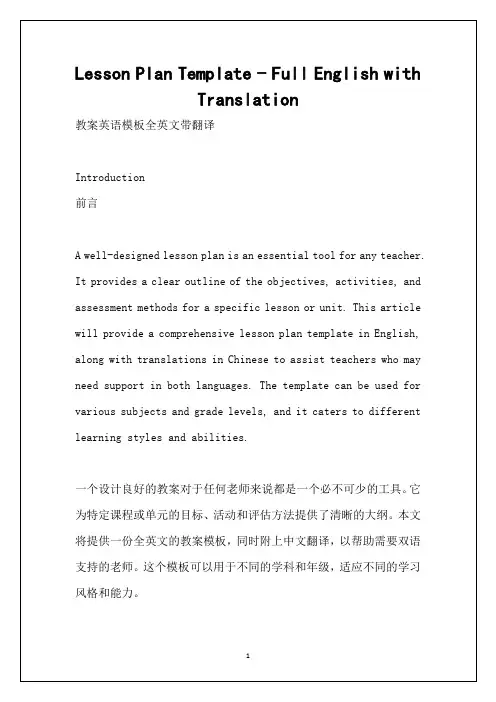
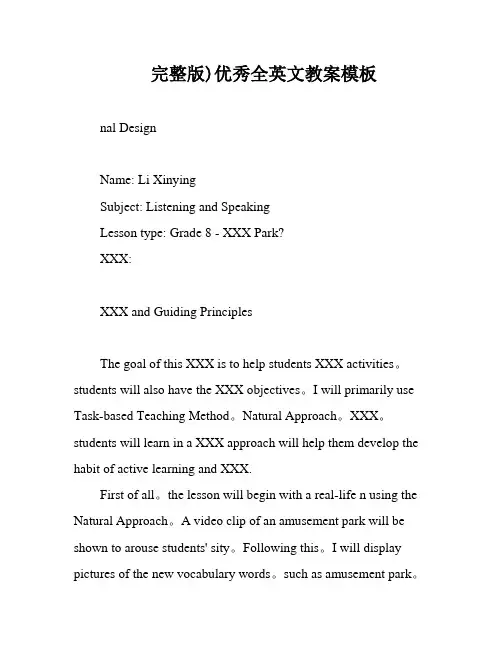
完整版)优秀全英文教案模板nal DesignName: Li XinyingSubject: Listening and SpeakingLesson type: Grade 8 - XXX Park?XXX:XXX and Guiding PrinciplesThe goal of this XXX is to help students XXX activities。
students will also have the XXX objectives。
I will primarily use Task-based Teaching Method。
Natural Approach。
XXX。
students will learn in a XXX approach will help them develop the habit of active learning and XXX.First of all。
the lesson will begin with a real-life n using the Natural Approach。
A video clip of an amusement park will be shown to arouse students' sity。
Following this。
I will display pictures of the new vocabulary words。
such as amusement park。
space museum。
aquarium。
and zoo。
to help students prepare for the XXX.In the third n。
I will use the Task-based Teaching Method to set three tasks for extensive listening。
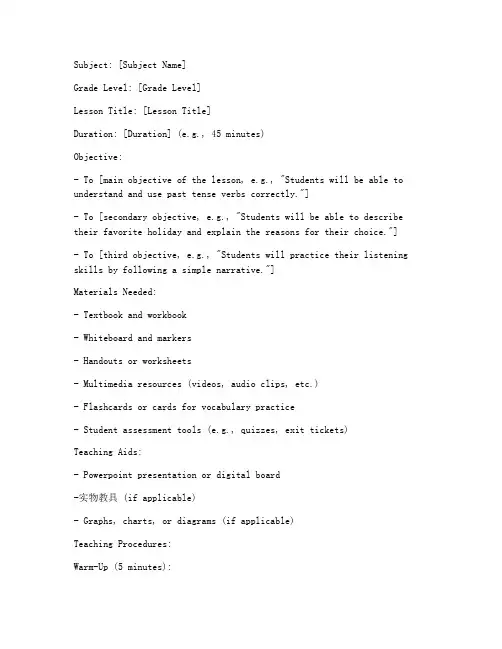
Subject: [Subject Name]Grade Level: [Grade Level]Lesson Title: [Lesson Title]Duration: [Duration] (e.g., 45 minutes)Objective:- To [main objective of the lesson, e.g., "Students will be able to understand and use past tense verbs correctly."]- To [secondary objective, e.g., "Students will be able to describe their favorite holiday and explain the reasons for their choice."]- To [third objective, e.g., "Students will practice their listening skills by following a simple narrative."]Materials Needed:- Textbook and workbook- Whiteboard and markers- Handouts or worksheets- Multimedia resources (videos, audio clips, etc.)- Flashcards or cards for vocabulary practice- Student assessment tools (e.g., quizzes, exit tickets)Teaching Aids:- Powerpoint presentation or digital board-实物教具 (if applicable)- Graphs, charts, or diagrams (if applicable)Teaching Procedures:Warm-Up (5 minutes):1. Greeting: Begin the lesson with a friendly greeting and check if any students are absent or have any special needs.2. Review: Quickly review the previous lesson's content to ensure students are prepared for the new material.3. Icebreaker: Conduct a brief activity or question to engage students and set a positive tone for the lesson.Introduction (10 minutes):1. Contextual Information: Provide background information or a hook to introduce the topic of the lesson.2. Objective Statement: Clearly state the lesson objectives and what students will be able to achieve by the end of the lesson.3. Visual Aids: Use visual aids to illustrate the main concepts or vocabulary.Instructor-Led Instruction (15 minutes):1. Direct Instruction: Explain the key concepts, vocabulary, and structures using clear and concise language.2. Demonstration: Model the task or activity for the students, ensuring they understand the expectations.3. Examples: Provide examples and explanations to illustrate the concepts.Group Work (15 minutes):1. Task Assignment: Divide students into small groups and assign a specific task or activity related to the lesson objectives.2. Guidance: Circulate among the groups to provide assistance and ensure that students are on track.3. Group Discussion: Encourage students to discuss their ideas and findings with their peers.Practice (15 minutes):1. Interactive Practice: Engage students in interactive activities such as role-plays, games, or pair work to reinforce the learning.2. Vocabulary Building: Introduce new vocabulary and provideopportunities for students to practice using it in context.3. Feedback: Offer immediate feedback and corrections to ensure students are on the right track.Independent Work (10 minutes):1. Homework Assignment: Provide a homework assignment that is relevantto the lesson and encourages further learning.2. Self-Reflection: Encourage students to reflect on what they have learned and how they can apply it in real-life situations.Conclusion (5 minutes):1. Summarize: Recap the main points of the lesson and reinforce the key concepts.2. Closing Activity: End the lesson with a closing activity that allows students to practice the new material in a fun and engaging way.3. Assessment: Collect any necessary assessment tools to evaluatestudent understanding and performance.Assessment:- Formative Assessment: Throughout the lesson, use quizzes, exit tickets, and observations to assess student understanding and participation.- Summative Assessment: At the end of the unit or lesson, use tests, projects, or presentations to evaluate student mastery of the material.Reflection:- After the lesson, reflect on the effectiveness of the teaching strategies and identify areas for improvement.- Consider how the lesson objectives were met and what adjustments could be made for future lessons.Additional Notes:- Be prepared to adapt the lesson plan as needed based on student responses and engagement.- Ensure that all students have equal opportunities to participate and succeed.- Maintain a positive and supportive learning environment.。
PEP六年级英语Unit 1 How do you go there?Period OneTeaching contents: Part A let's learn & let's playTeaching aims:1. To enable the students to master the four skills phrases: on foot,by bike,bybus,by train, by plane,by ship,by subway2. To enable the students to ask about the ways of traffic with the followi ngsentence patterns: How do you go to school? Or How do you go to Canad a…?‖And answer with―I go by…‖Teaching focus:To master the four skills phrases: by train, by plane, by subway, by ship, by bike,on footTeaching difficulty:To differ ―subway‖ from―train‖Teaching methods:Communicative ApproachTeaching aids:1. Word cards2. Tape recorder and tape 3。
Multi—media playerTeaching procedure:1。
(Warm—up)Greeting: Good morning , class ! Glad to meet you again. How are y ou?What day is it? What ‗s the date?What‘s the weather like today?2. PresentationShow a picture of busT: What‘s this? S: It‘s a bus.T: I go to school by bus。
英语教学教案模板英文版优秀5篇篇一:英语教案篇一活动名称:《H Hat》活动目标:1、通过利用各种游戏活动让幼儿反复听、说、读、练,在游戏活动中学习并掌握英语字母:“H”、英语单词:“Hat”的正确发音及译义,理解短语:“Be quiet!Listen。
”的实际译义。
2、初步培养幼儿的英语对话能力。
活动准备:准备字母卡、图卡一张,录音机及《阳光幼儿英语》音乐磁带。
活动过程:1、活动开始,师幼例行问候,引起幼儿英语活动的兴趣,并进行热身运动。
2、创设情景进行英语对话,复习所学过的会话内容,奖励复习出色及有进步的幼儿,并介绍本节课将要学习内容的重点。
3、教授新字母“H”及新单词“Hat”。
(1)教师出示字母娃娃H,让幼儿说出像什么,在拼贴字母的过程中学会字母“H”的正确发音。
(2)教师利用图卡引出“帽子”的英语单词,通过游戏“贴帽子”让幼儿反复练习强化,逐渐掌握单词“Hat”的正确发音及译义。
4、律动教学。
教授幼儿短语“Be quiet!Listen。
”的实际译义及相应的动作。
5、教师小结,叮嘱幼儿:“回家要看VCD,回家要听录音机,回家要当Melody!”篇二:高中英语教学设计篇二一、课程类型:高三复习课二、教学目标:一) 认知目标1、句型和语言点(见教学重点)。
2、用所学的知识与伙伴进行交流、沟通,学会改错、写作。
二)情感目标利用多媒体手段营造积极和谐教学氛围,使学生不自觉地进入情景之中,充分调动学生的思维活动和情感体验,引起学生的共鸣。
三)智力目标在运用语言的过程中培养学生的观察力、分析力、想象力和自学能力,帮助学生加强记忆力,提高思维能力和运用英语的综合能力,激发创造能力。
三、教材分析:这是高三复习阶段的一节写作课。
这节书面表达课就从审题谋篇等方面入手来完成教学目的,侧重于引导学生在把握书面表达的写作前准备即谋篇审题能力,使学生在动手写作前迅速构思按照规范的模式来完成谋篇审题:在教学中不仅仅强调写,对于与写作紧密联系的听、说、读、改错都有兼顾。
英语教案模板全英文English Lesson Plan TemplateI Teaching ObjectivesA Language Skills1、 Students will be able to master new vocabulary related to the topic2、 Students will be able to understand and use target grammar structures accurately3、 Students will be able to improve their listening, speaking, reading and writing skills through various activitiesB Knowledge Objectives1、 Students will gain knowledge about the cultural background related to the lesson2、 Students will understand the main idea and key points of the text or materials presentedC Emotional and Value Objectives1、 Students will develop an interest in learning English2、 Students will enhance their confidence in using EnglishII Teaching Key PointsA VocabularyIntroduce and explain new words and phrases that are essential for understanding the lessonB GrammarHighlight and explain the target grammar structure, and provide sufficient practiceC Text ComprehensionHelp students understand the main idea, details and logical structure of the textIII Teaching Difficult PointsA Complicated Grammar StructuresSolve students' confusion and difficulties in understanding and applying complex grammar rulesB Abstract ConceptsMake abstract or difficult concepts easier to understand through vivid examples and explanationsC Cultural DifferencesHelp students bridge the gap in understanding cultural differences to better comprehend the languageIV Teaching MethodsA Communicative ApproachEncourage students to communicate and interact in English to improve their language proficiencyB TaskBased LearningAssign various tasks to students to enhance their problemsolving skills and language application abilityC Multimedia TeachingUse pictures, videos, and audio materials to make the lesson more vivid and interestingV Teaching AidsA Textbooks and WorkbooksUse the prescribed textbooks and supplementary workbooks for systematic teaching and practiceB Multimedia ResourcesPrepare PPTs, videos, audio clips, and online materials to support teachingC Realia and ModelsUse real objects or models to help students understand and remember the knowledge betterVI Teaching ProcedureA Leadin1、 Start the class with a warmup activity such as a short video, a song, or a simple question to arouse students' interest and attention2、 Relate the warmup to the topic of the lesson and introduce the main learning objectivesB Presentation1、 Present new vocabulary and grammar through examples, pictures, or context2、 Explain the meaning and usage of the new language items clearly and simplyC Practice1、 Provide various exercises for students to practice the new vocabulary and grammar, such as fillintheblanks, sentencemaking, and translation2、 Organize pair or group work to allow students to practice communicating with each other using the new languageD Reading/Listening Comprehension1、 Present a reading or listening text related to the topic2、 Set comprehension questions to guide students to understand the main idea, details and key information of the textE Production1、 Ask students to apply the language they have learned to reallife situations, such as roleplay, debate, or composition writing2、 Provide feedback and correction to students' performanceF SummarySummarize the key points and language points learned in the lesson to reinforce students' memoryG HomeworkAssign appropriate homework to consolidate what has been learned in class, such as exercises, reading or writing tasksVII Blackboard DesignWrite the key vocabulary, grammar rules and important points on the blackboard during the lesson for students to refer toVIII Teaching ReflectionAfter the lesson, reflect on the teaching process and students' learning performance, summarize the strengths and weaknesses, and make improvements for future teachingThis is a basic template for an English lesson plan Depending on the specific content and teaching requirements, teachers can make appropriate adjustments and enrichments The key is to design a lesson that is interesting, effective and suitable for students' language level and learning needs。
英语教案设计范文全英
第一部分:教学目标
1. 目标描述
本节课的教学目标旨在帮助学生掌握英语中的基础语法和词汇知识,以便能够流利地进行日常对话和交流。
2. 学习内容
•英语基础语法知识
•常用英语词汇
3. 学习目标
•理解并正确运用英语基础语法规则
•能够准确地运用所学词汇进行口语表达
第二部分:教学过程
1. Warm-up (10分钟)
•通过简短的问候和介绍活动引导学生进入学习状态。
2. Presentation (20分钟)
•通过例句和语法规则的讲解来帮助学生理解英语的语法知识。
•演示并让学生模仿正确的口语表达方式。
3. Practice (30分钟)
•分组进行练习,让学生在实际交流中运用所学知识。
•组织口语练习,让学生能够流利地进行对话。
4. Production (20分钟)
•让学生展示他们在课堂中学到的知识,进行口语表达。
•根据实际情况给予指导和反馈。
第三部分:教学评估
1. 评估方式
•通过学生的口语表达和课堂表现来评估他们对所学知识的掌握程度。
2. 评估标准
•能够准确使用所学语法知识进行口语表达
•能够流利地进行日常对话和交流
第四部分:课堂总结
通过本节课的学习,学生应该掌握了日常英语中的基础语法知识和常用词汇,能够更加流利地进行英语口语表达。
希望同学们在日常生活中多加练习,巩固所学知识,提高自己的英语能力。
以上是本节课的教案设计范文,希望对教师有所帮助。
2024年英语全英语教案模板8篇英语全英语教案模板篇1一、教学目标1、语言知识did you …?yes,i did./no,i didn’t.2、语言技能能运用did you …?句型询问对方是否做过某事,对方根据具体情况作出应答yes,i did./no,i didn’t.培养学生在具体情景中正确运用该语言的交际能力。
3、情感态度培养学生团队协作能力和与他人合作的精神以及用英语做事情的基本技能,激发学生竞争意识。
4、学习策略培养学生积极与他人合作,主动学习,积极运用英语进行表达和交流,与同学共同完成学习任务的能力。
二、教学重难点能熟练运用did you …?句型对过去发生的事情进行推测。
Ⅰ.warm-up1.came: ①教师快速出示动词或动词词组,让学生快速做出该动作。
②让学生从另一组动词过去式中找出与图片配对的单词,学习和巩固不规则动词过去式。
如:go-went, meet-met, run-ran, buy-bought, eat-ate, see-saw.2.free talk用“旅游日记”或“假期影集”与组员谈论假日生活。
如:where did you go on vacation?what did you do?did you……?when did you come back?Ⅱ.pre-task1、教师出示提前收集的名胜风景区明信片,提问:“did you go to ……?” did you see……? did you buy……?2、教师出示英国伦敦的名胜风景区明信片,提问:“where did lingling go?”学生回答:“london”.教师问:“where did she go?what did she see/meet/buy?”学生回答后,教师引出课文活动5的歌曲:“listen to a song from amy”,学唱歌曲。
3、[任务呈现]——寄一张风景明信片给你的朋友教师展示伦敦明信片,并介绍:“this is from amy to daming.what did she say? let’s go and see.then please write about your yesterday to amy or your friends.”让我们一起瞧一瞧怎样写明信片呢?Ⅲ.while-task1、播放课文录音,并让学生回答课文活动的问题。
课程目标:1. 培养学生用英语进行写作的基本能力。
2. 提高学生的英语写作技巧,包括句型结构、词汇运用和段落组织。
3. 增强学生的英语思维能力和文化素养。
教学对象:大学英语专业一年级学生教学时间:2课时教学工具:多媒体教学设备、投影仪、笔记本电脑、英语写作教材教学过程:第一课时:一、热身活动(Warm-up)1. 学生自由讨论:请学生分享自己最近看过的英文书籍或文章,并简要介绍自己的阅读感受。
2. 教师简要介绍本节课的学习目标。
二、新授课(New lesson)1. 教师讲解英语写作的基本结构:引言、主体和结论。
2. 通过实例分析,讲解常见的句型结构和词汇运用。
3. 分组讨论:学生以小组为单位,就某个话题进行头脑风暴,准备写作素材。
三、实践练习(Practice)1. 学生根据所给话题,独立完成一篇英语短文。
2. 教师巡视指导,纠正学生的错误。
四、课堂展示(Presentation)1. 学生展示自己的写作成果,教师进行点评。
2. 学生之间互相评价,提出改进意见。
第二课时:一、复习上节课内容(Review)1. 教师简要回顾上节课的学习内容。
2. 学生分享自己在写作过程中遇到的问题及解决方法。
二、巩固练习(Consolidation)1. 教师提供一篇英语短文,要求学生根据文章内容进行改写或续写。
2. 学生独立完成改写或续写任务。
三、课堂展示(Presentation)1. 学生展示自己的改写或续写成果,教师进行点评。
2. 学生之间互相评价,提出改进意见。
四、总结与反馈(Summary and feedback)1. 教师对本节课的学习情况进行总结。
2. 学生分享自己在学习过程中的收获与不足。
3. 教师针对学生的反馈,提出改进建议。
教学反思:本节课通过讲解英语写作的基本结构和技巧,帮助学生掌握了英语写作的基本方法。
在实践练习环节,学生能够运用所学知识进行写作,并在课堂展示中展示自己的成果。
但在课堂展示环节,部分学生表达不够流畅,需要进一步提高口语表达能力。
PEP六年级英语
Unit 1 How do you go there?
Period One
Teaching contents: Part A let’s learn & let’s play
Teaching aims:
1. To enable the students to master the four skills phrases: on foot,by bike,by
bus,by train, by plane,by ship,by subway
2. To enable the students to ask about the ways of traffic with the follow ing
sentence patterns: How do you go to school? Or How do you go to Canad a…?‖And answer with―I go by…‖
Teaching focus:
To master the four skills phrases: by train, by plane, by subway, by ship , by bike,
on foot
Teaching difficulty:
To differ ―subway‖ from―train‖
Teaching methods:
Communicative Approach
Teaching aids:
1. Word cards
2. Tape recorder and tape
3. Multi-media player
Teaching procedure:
1. (Warm-up)
Greeting: Good morning , class ! Glad to meet you again. How are y ou?
What day is it? What ‗s the date? What‘s the weather like today?
2. Presentation
Show a picture of bus
T: What‘s this? S: It‘s a bus.
T: I go to school by bus. How do you go to school?
(Show a picture of bike and help a student to answer with --I go to school by bike.‖)
(In the same ways)Teach ―by subway‖ and ―by train‖―by ship‖―by plane‖―on foot‖)
Subway: It's an underground railway in a city.It travels very fast.We can see subway in Hong Kong, Beijing, Shanghai, Gongzhou… Explain t he differences between subway and train Pay attention to the pre. ― by ‖& ―on‖
3. Play games
Ask one S to the front and stick the word cards next to the phrases written on the Bb when T read the new phrases quickly and the other Ss put up t heir cards. The one who reflect fastest and correctly is the winner.
4. Listen to the tape of Part A Let‘s learn and follow it.
Pay attention to the tone and pronunciation
5. Practice: Let‘s play
T Offer many places (the USA. England Australia Hong Kong Shanghai Guangzhou the moon…) and traffic ways (by car/ taxi/ bus… on foot) Ss practice with above places and ways in pairs:
A: How do you go to school?
B: I go to school on foot .
Encourage the Ss to make up as many sentences as they can.
6. Spelling competition
Divide the class into tow groups. Show the pictures of traffic tools and as k Ss to spell the phrases. The first one who puts up hand gets the chance t o spell. The group spell out more phrases are the winners. Homework
Copy the new words and phrases Finish Page1 of the AB
Bb design:
Unit One How do you go there?
How do you go to school/ Canada?
I go to school on foot/ by subway/ bus/ train/ taxi…。